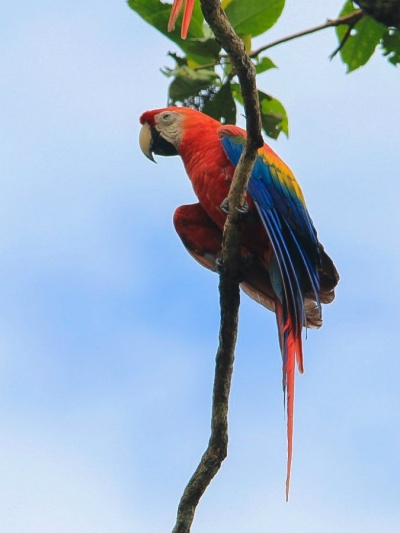- Ara macao
Identification
Length 81-96 cm (32-36 in). More than half of their length is the pointed, graduated tail typical of macaws.
Weight 1 kg (2-2.5 pounds)
- Mostly scarlet
- Light blue rump and tail-covert feathers
- Greater upperwing coverts yellow
- Dark blue supperside of wings and tail
- Dark tail feathers with metallic gold iridescence
- Bare white skin around eye, extending to bill
- Upper mandible mostly pale horn; lower mandible black
Sexes are alike. Young birds have dark eyes.
Similar Species
Red-and-green Macaw has red feathered lines on bare face and green, not yellow or blue median coverts. Red color deeper on Red-and-green. Scarlet has proportionately longer tail. Scarlet's call is coarser and lower pitched.
Variations
Nominate race has green, rather than blue tips to its median coverts.
Distribution
Eastern Mexico locally to Amazonian Peru and Brazil, in lowlands up to 500 meters (at least formerly up to 1000m). It has been widely extirpated by habitat destruction and capture for the pet trade. Formerly it ranged north to southern Tamaulipas.
In Central America, local populations survive in Guatemala (Peten Province), Belize (a few individuals on the western border with Guatemala), Honduras (Gracias a Dios Department with some in neighboring departments), Nicaragua (eastern, with possibly a few individuals surviving in the far northwest of the country), Costa Rica (2 populations in Puntarenas Province, one around Carara National Park (350 birds), and another on the Peninsula de Osa - ca.800 birds, some individuals crossing the northeast border from Nicaragua, and two growing populations of reintroduced scarlet macaws[1] near Pavones in the southwest, and Paquera on the Peninsula de Nicoya). Locally extinct in El Salvador. In Panama, it can still be found on the island of Coiba and a few seem to survive in the Azuero Peninsula.
Taxonomy
Subspecies
Two subspecies are recognized:[2]
- A. m. cyanopterus - South-eastern Mexico to Nicaragua
- A. m. macao - Costa Rica to Colombia, the Guianas, Brazil, Peru and Bolivia
Habitat
Pacific secondary rain forest at ca. 130 m (427 ft) elevation, coastal woods.
Behaviour
They are often seen singly and in pairs (occasionally in flocks) flying over the forest canopy.
Diet
They mostly eat fruits and seeds, including large, hard seeds. They do visit clay licks.
Breeding
Their clutch consists of 2 to 4 white eggs laid in a tree cavity. The young hatch after 24 to 25 days. They fledge about 105 days later. They are reliant on the parents for up to a year.
Voice
Loud, low-pitched, throaty squawks and screams. Fight call: a raspingraah.
Movements
Seasonal movements in search of fruit.
In Culture
It is the Honduran national bird.
References
- Forbes D. 2006 Reintroducción exitosa de la lapa roja (Ara macao) en los bosques secos y húmedos de Costa Rica: Supervivencia, movimientos y dieta. in O. Chassot, G. Monge & M. Lezama (Eds) Actas del Primer Simposio Mesoamericano de Psittaciformes. La Ceiba, Honduras: Red Mesoamericana de Conservación de Psittacidos, pp 96-103.
- Clements, J. F., T. S. Schulenberg, M. J. Iliff, D. Roberson, T. A. Fredericks, B. L. Sullivan, and C. L. Wood. 2018. The eBird/Clements checklist of birds of the world: v2018. Downloaded from http://www.birds.cornell.edu/clementschecklist/download/
- Marineros L. & Vaughan C. 1995 Scarlet Macaws of Carara. in J. Abramson, B. Speer & J. Thomsen (Eds) The Large Macaws: Their Care, Breeding and Conservation. Fort Bragg, CA: Raintree, pp 445-467.
- Birdforum thread discussing id of Red-and-green Macaw vs Scarlet Macaw
- BirdForum Member observations
- Animal Corner
- Collar, N., Boesman, P. & Sharpe, C.J. (2019). Scarlet Macaw (Ara macao). In: del Hoyo, J., Elliott, A., Sargatal, J., Christie, D.A. & de Juana, E. (eds.). Handbook of the Birds of the World Alive. Lynx Edicions, Barcelona. (retrieved from https://www.hbw.com/node/54620 on 3 July 2019).
- Scarlet Macaw (Ara macao), In Neotropical Birds Online (T. S. Schulenberg, Editor). Cornell Lab of Ornithology, Ithaca, NY, USA. retrieved from Neotropical Birds Online: https://neotropical.birds.cornell.edu/Species-Account/nb/species/scamac1
Recommended Citation
- BirdForum Opus contributors. (2024) Scarlet Macaw. In: BirdForum, the forum for wild birds and birding. Retrieved 26 July 2024 from https://www.birdforum.net/opus/Scarlet_Macaw
External Links
GSearch checked for 2020 platform.1






